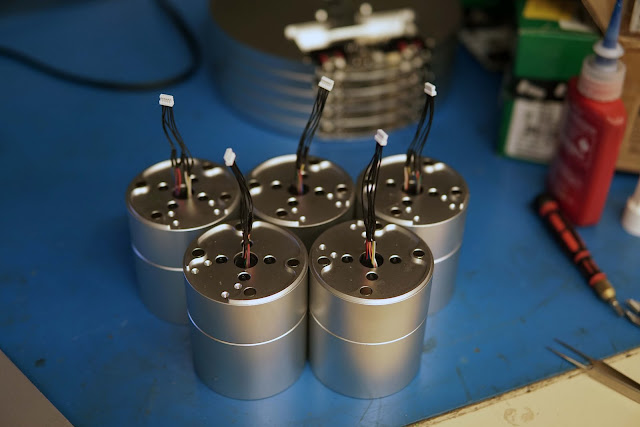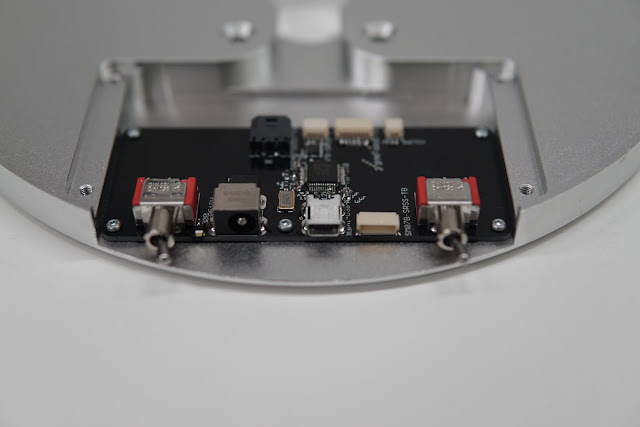Since the original furuta pendulum was all built out of scrap I had lying around, I had to redesign pretty much everything from scratch.
Instead of using a hand-skewed motor like the original, I used a custom-wind of a T-motor gimbal motor. These have low enough cogging torque to work pretty well:
Each motor gets a Microfit connector crimped on the leads, and a hollow shaft retaining-compounded in, for the encoder wheel to attach to:
The spindle has a pair of bearings very lightly preloaded by a wavy washer, and a diametrically magnetized magnet in the back which is read by a hall encoder:
In the base is a US digital 20k count/rev optical encoder which the wires for the pendulum hall encoder pass through:
SPI to the pendulum encoder gets passed over a 12-pin slip ring, with each pin doubled-up for (hopefully) better reliability:
In the base there's a board with power switch, mode switch, DC input jack, USB connector for serial communication, and programming header on it. The mode switch allows the pendulum control to be done by the on-board motor controller, or by taking commands and passing back sensor outputs over serial to a computer running the controller.
I didn't want any screws to show, so the top is held on by 4 magnets:













I find one screw shown on the pendulum's shaft :p
ReplyDeleteI'd love to buy one of these! Kickstarter campaign maybe?
ReplyDeleteThese are beautiful!
ReplyDeleteIt could be a nice desktop decor! consider to find OEM and sell it?
ReplyDeleteAre the design files open source or can I buy one?
ReplyDeleteAny chance to get the files? Seems you don't share anymore maybe because the chinese stole your Cheetah design?
ReplyDeletehttps://github.com/bgkatz/Furuta-Pendulum
DeleteHi, Ben.
ReplyDeleteWould it be fine to use a 1024ppr encoder instead of your 5000ppr?
A friend of mine and me want to rebuild the project. We saw that the used slip ring (M125A-12 by Senring) is only rated to 250RPM but the supplier writes it can make faster ones on request. Was the stock M125A-12 sufficient, or was a modified version used? Really love the design!
ReplyDeleteI used the stock slip ring
DeleteInstead of the GB54-2 (KV26) there also exists the GB54-1(KV33). The GB54-1 version from T-Motor has a higher KV. As i understand this higher KV Value should not impact cogging torque. Why was not the higher KV version used in the project. It would make the system more dynamic. (I believe this must have been a conscious design decision, and wonder why.)
ReplyDeleteI actually got a custom-wound 100kv version of the GB54. T-motor will do custom windings for a bit extra cost. It was around $100/motor for the custom wound version.
ReplyDeleteHello Ben,
ReplyDeleteThank you so much for posting all of this. I am looking to make a furuta pendulum and was wondering why you chose to go with a custom-wound GB54 as opposed to the lower stock models.
Thanks,
Justin L
For higher speed/power given the bus voltage I wanted to run
DeleteThank you for open sourcing this, it is a great hobby project. I found my bearings with metal shield add a lot of friction (chinese ones from aliexpress) the pendulum is damping a lot faster than yours. Did you do any improvements on the bearings to make them lower friction? Cheers!
ReplyDeleteI actually ran into the exact same problem. I ended up swapping the bearings for more expensive versions from McMaster, and those had much less friction.
DeleteSo cool, to be on the same path. Thanks for the tip :))
Delete